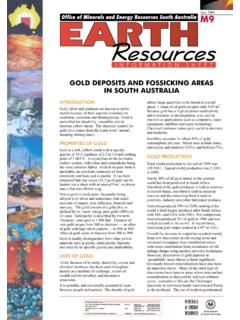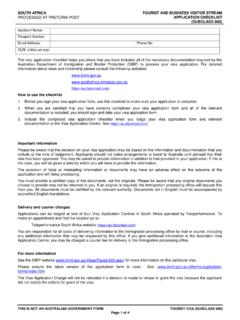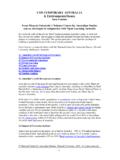Transcription of OECD REVIEW OF CAREER GUIDANCE POLICIES
1 OECD REVIEW OFCAREER GUIDANCE POLICIESDIAPSH6 UDPIBVD96I8@8 PVIT@GGDIBAUSTRALIACOUNTRY NOTEV isit: March 2002 Revised: May 2002 australia has granted the OECD permission to include this document on the OECD Internet Home views expressed in the document are those of the author(s) and not necessarily those of australia , theOECD or its Member countries. The copyright conditions governing access to information on the OECDHome Page are provided at: ,3380,EN-document-592-17-no-21-17182-592 -no-no, the autumn of 2000 the OECD s Education Committee and its Employment, Labour andSocial Affairs Committee endorsed a comparative REVIEW of CAREER information, GUIDANCE and counsellingpolicies.
2 Participating countries complete a detailed national questionnaire, and after its completion host ashort visit by an expert REVIEW team. australia was the fifth country to host such a visit, from 18 to 26 March The team had meetings with policy-makers and GUIDANCE practitioners in four states (NewSouth Wales, Queensland, Victoria and Western australia ) and at national Commonwealth level; it alsovisited six schools, a university, a Job Network provider, a user-pays CAREER counselling service, a careerplanning unit within a public-service employer, and a public CAREER information upon the visit, the draft national questionnaire response and other documentation, thisreport summarises the impressions of the REVIEW team, and its suggestions for ways in which POLICIES forcareer information, GUIDANCE and counselling might be further developed in australia .
3 After a briefcontextual introduction, the report describes the key features of the main parts of the guidance3 system,including some comments on each. It then offers some general comments on five key topics: CAREER education and VET/transition programmes in schools. Tertiary education. Services for adults. Professional standards. Strategic co-ordination and is the sixth largest nation in land area, but has a relatively small population (just over 19million), many of whom live in the major coastal cities. Foreign-born immigrants form an unusually high 1 For members of the REVIEW team, see Appendix For the REVIEW visit programme, see Appendix Here and elsewhere the term GUIDANCE is often used generically, as shorthand for CAREER information, GUIDANCE and counselling services.
4 3proportion ( ) of the population (the EU average is ).4 australia has recently enjoyed a period ofsustained economic growth: between 1990 and 2000 its GDP grew on average by , as against anOECD average of A high proportion of its workforce is employed in the service sector (in 1999, as opposed to an OECD average of ). As many as of jobs are part-time (OECD average ). The Australian labour market is relatively flexible: for example, legislated employmentprotection is less extensive than in some other OECD countries. The unemployment rate in 2000 wasexactly the same as for OECD as a whole ( ); the rate among young people aged 15-24 was (OECD average ).
5 Long-term unemployment is particularly high among Indigenous Australians, insome regional areas ( some traditionally dependent on manufacturing) and among early school-leaversand older of post-compulsory educational participation in australia have grown rapidly in the lasttwo decades: whereas in 1981 its rate for 17-year-olds was lower than in leading OECD countries, it hassince become comparable with such The rise was initially closely linked to the collapse of theyouth labour market and the growth of youth unemployment. This led to policy concern that, if the rise wasto be sustainable, changes were needed in the structure and curriculum of secondary schools, which werestrongly oriented towards preparing young people for university study.
6 Accordingly, much effort has beenmade in recent years to develop better ways of meeting the needs of the majority of school leavers who donot proceed to university. In particular, steps have been taken to introduce into schools new vocationaleducation and training (VET) general, the education and labour market systems are more loosely coupled in australia thanin some other OECD countries. Thus young people s pathways into work tend to be individuallyconstructed rather than institutionally based. The fact that the labour market is relatively open and lessdependent on occupationally-linked qualifications means that young people are often able to try out avariety of jobs as part of their CAREER maturation.
7 Because much of the employment of young people is part-time and casual in nature, their early work experiences are often episodic and the adult population, the proportion with tertiary qualifications is higher than the OECD average, but the proportion with upper-secondary qualifications is lower. The proportion of 25-64-year-olds participating in continuing education and training is also lower (27%, as against an OECD average of31%). 4 Except where stated otherwise, these and other figures cited here are taken from standard OECD andAustralian government Boston Consulting Group (2001), Pathways to Work: Preventing and Reducing Long-Term OECD (1997), Thematic REVIEW of the Transition from Initial Education to Working Life: Country Note onAustralia, Lamb, S.
8 & McKenzie, P. (2001), Patterns of Success and Failure in the Transition from School to Work inAustralia. LSAY Research Report Melbourne, Australian Council for Educational AUSTRALIAN GUIDANCE , australia has a federal structure, with major governmental responsibilities beingdivided between the Commonwealth and the six states and two territories (hereafter referred to collectivelyas states ). The states are responsible for providing schooling. The Commonwealth provides additionalfunds to the states for schools, and also provides funds to non-government schools. In addition, through theMinisterial Council on Education, Employment, Training and Youth Affairs (MCEETYA)8, theCommonwealth works with the states to identify national standards and priorities.
9 However, each state hasits own curriculum authority. In the post-compulsory vocational education and training system, where thestates also have constitutional responsibility, there have been stronger moves towards national consistencythrough the Australian National Training Authority (ANTA) Ministerial Council9. In this sector too, aswith schools, the Commonwealth provides additional funding to the states. In the university sector thestates have the principal legislative responsibility, including that for accrediting private providers courses,whilst the Commonwealth has the primary responsibility for funding and policy-making (though as inmany other OECD countries the universities have a large measure of autonomy).
10 The provision ofemployment services is a Commonwealth responsibility; some states choose to offer additional administrative and financial structures largely dictate the structure of the GUIDANCE systemin australia . Many of the main GUIDANCE services are concentrated in the schools and therefore come understate jurisdiction. There are also services in the vocational education and training system (particularly thetechnical and further education (TAFE) institutes) and in the universities. Commonwealth employmentservices have been largely contracted out to private providers. For this and other reasons, there is a largerprivate sector in the GUIDANCE field in australia than in some other OECD main co-ordinating mechanism for GUIDANCE services in australia is MCEETYA, whichbrings together the ministers with education, employment, training and youth affairs portfolios atCommonwealth and state levels.















